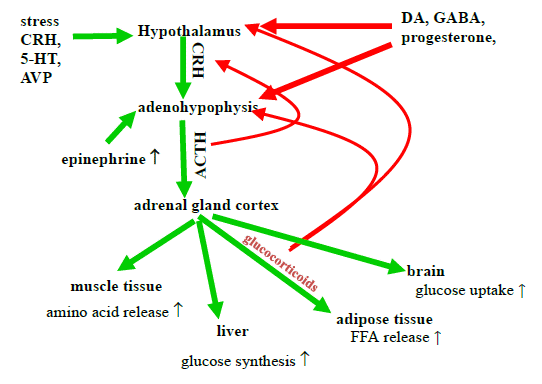III.3.F. The effects of glucocorticoids
Glucocorticoids are synthesized from cholesterol in the zona fasciculata of the AGC. They are produced in a circadian rhythm. The levels are higher in the morning.
The ratio of the two main hormones: cortisol:corticosterone = 7 : 1.
The main effects of cortisol (Fig. 9.):
1. Carbohydrate metabolism:
gluconeogenesis ↑ – liver glycogen ↑
insulin antagonist
blood Glu level ↑ – glycosuria, Cushing disease, steroid diabetes
glucagon secretion ↑
adipocytes and muscle Glu uptake ↓
Glu release from the liver ↑
glycogen synthesis ↑
GH level ↑
2. Protein metabolism:
antianabolic (amino acid – protein alteration ↓)
protein breakdown ↑ (protein catabolism)
nitrogen content ↓
3. Lipid metabolism
(this is not fully known)
the fat distribution is changed
serum triglyceride and cholesterol level ↑, HDL level ↓
fat breakdown (lipolysis) ↑, FFA level ↑
4. H2O and electrolytes:
diuresis ↑, antidiuretic hormone (ADH) synthesis ↓
Na+ reabsorption ↑, but the renal glomerular filtration rate (GFR) ↑, and the daily amount of filtration ↑, so the overall effect is Na+ release ↑;
renal K+ excretion ↑
Na+ and K+ exert their effects through the aldosterone receptors in the kidney.
5. Bones:
cartilage development and bone formation ↓ (osteoblast cells are inhibited)
Ca2+ secretion in the kidney ↑, Ca2+ uptake in the intestines ↓
adults: osteoporosis
children: dwarfism
6. Circulatory system (important for a normal BP):
BP ↑, angiotensin receptor sensitivity ↑
E sensitivity ↑
extended effect of catecholamine
red blood cell number ↓
inhibits prostanoid-caused vasodilatation
(this causes high BP in Cushing disease patients)

Figure 9. The effects of glucocorticoids
(ADH, AVP = vasopressin (arginine vasopressin) or antidiuretic hormone, DA = dopamine, GABA = gamma amino butyric acid, FFA = free fatty acid, CRH = corticotrophin releasing hormone, ACTH = adrenocorticotropic hormone, 5-HT = serotonin (5-hydroxytryptamine);
red arrow = inhibition, green arrow = stimulation)
The lack of GH and the overproduction of glucocorticoids (Cushing syndrome) are closely similar to the MetS (Table 2).
|
Metabolic syndrome |
Glucocorticoid overproduction |
The lack of growth hormone |
|
|
body composition |
obesity ↑, (mainly abdomen and waist) |
cervico-dorsal fat pad, waist–hip ratio ↑ abdominal obesity ↑ body weight ↓ bone mineral content ↓ |
waist–hip ratio ↑ abdominal obesity ↑ body weight ↓ bone mineral content↓ |
|
glucose metabolism |
fasting blood glucose ↑ insulin resistance ↑ |
fasting blood glucose ↑ |
insulin resistance ↑ |
|
lipid metabolism |
fasting HDL ↓ fasting TG ↑ |
fasting HDL ↓ fasting TG ↑ total cholesterol ↑ |
fasting HDL ↓ fasting TG ↑ total cholesterol ↑ Apo B ↑ LDL ↑ |
|
blood pressure |
systolic and diastolic blood pressure ↑ |
systolic and diastolic blood pressure ↑ |
at the beginning of the lack ↓ after the development of insulin resistance ↑ |
|
physique |
|
muscle mass ↓ |
muscle mass and strength ↓ |
|
mental condition |
depression ↑ |
libido ↓ rapid mood changes predisposition to alcoholism↑ |
libido ↓ daily problems solution ↓ self-respect ↓ physical and mental energy ↓ |
|
circulation |
predisposition to circulatory disorders↑ |
number of circulatory disorders ↑ higher mortality |
number of circulatory disorders↑ |
|
hormone levels |
plasma cortisol ↑ ACTH sensitivity ↑ IGFBP ↓ |
|
IGF-1 level ↓ |
Table 2. A comparison of the symptoms caused by the metabolic syndrome, glucocorticoid overproduction and the lack of growth hormone
Plasma cortisol levels are increased in MetS patients.
Interestingly, a low cortisol level is measured in obese, but non-MetS patients. The ACTH sensitivity is higher in MetS patients, which causes a high cortisol level. In these patients, the glucocorticoid sensitivity of the tissues is higher.
The inactive glucocorticoids are converted into active forms by 11β-hydroxysteroid dehydrogenase type 1 (11HSD1) produced in the liver and adipose tissues. In genetically modified mice, the overproduced enzyme in the adipose tissues causes obesity, Glu intolerance, dyslipidemia and high BP, while in the liver it causes only insulin sensitivity and high BP. In enzyme non-producing, genetically modified mice, the MetS does not develop in response to a high fat and Glu diet.